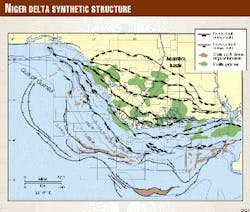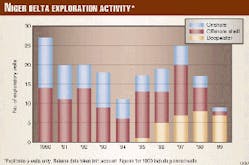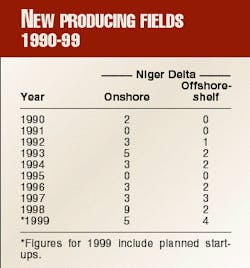Since the early 1990s, oil operators have focused attention on the deepwater part of the Niger Delta (Fig. 1), where the first exploration licenses were attributed in 1993 and successful drilling started in l995.
Until 1997, the overall level of exploration activity was quite insignificant; in 1998 and 1999, however, activity dramatically shifted to the deepwater (Fig. 2) as operators dropped the onshore and shelf areas due to maturity as well as to security concerns.
The number of new fields being placed on production has also remained at high levels (Table 1). It should be recalled that in 1996 the Nigerian government issued a decree whereby any oil discovery left unattended for more than 10 years on an operated block could be farmed out or requested to be farmed out to indigenous companies helped by foreign investors.
The guidelines issued later by the directorate seem to have reduced the delay to 5 years.
There have been some takers. Three indigenous companies have signed farmout agreements with two major operators concerning five undeveloped discoveries, three offshore and two onshore.
Unproduced discoveries
A careful screening of all undeveloped discoveries indicates that 337 discoveries totaling 3.737 billion bbl of oil exist in the onshore and offshore areas combined. The breakdown:
Onshore: 197 unproduced discoveries totaling 2.099 billion bbl of recoverable reserves (average 11 million bbl/discovery, largest 150 million bbl).
Offshore: 140 unproduced discoveries totaling 1.638 billion bbl of recoverable reserves (average 12 million bbl/discovery, largest 80 million bbl).
A large number of these discoveries have been left to lie for 5-10 years. Many of them are one-well discoveries. The summary map of the delta shows how the producing fields are grouped in prolific patches favored by geological factors (Fig. 1).
Most of the unproduced discoveries are situated outside those patches. Not all of them are technically capable of producing, but a careful screening shows that a substantial number may turn into viable, economic production, certainly those onshore discoveries in the vicinity of existing pipeline grids and infrastructure.
The recoverable reserves of the five unproduced discoveries cited above are in the higher-end bracket. This may encourage small, less risk-minded operators to set foot in this important hydrocarbon province.
Those operators that have a financial situation enabling them to get involved into exploration-prone projects but for which the deepwater offshore is indeed too risky and expensive may invest in the onshore and offshore-shelf blocks that still have a substantial potential.
Some of those blocks are in the hands of operators looking for financial and technical help, while most of them have been retrieved from indigenous operators who had stayed inactive too long. This does not mean that those accessible blocks have no value.
Accessible blocks
An impartial screening of all of them, onshore and offshore-shelf, in a very conservative and restrictive manner, indicates that there are presently 19 accessible blocks onshore and 12 offshore-shelf, with an overall potential of 45 probable or possible prospects with total recoverable reserves of 1.490 billion bbl. The breakdown between onshore and offshore shelf is:
Onshore: 19 blocks with 22 prospects totaling recoverable reserves of 975 million bbl (average 44 million bbl/prospect).
Offshore: 12 blocks with 23 prospects totaling recoverable reserves of 515 million bbl (average 22 million bbl).
While some of the blocks have no value and have been rightly left aside, some others onshore and on the offshore shelf are worth an exploration effort with average or very limited risk. As an explorationist, it is the author's opinion that with an average and steady success ratio (suspended + completed exploration wells / total exploration wells) of 51% over time, the risk is worth taking.
The best recent example is a block situated in the eastern offshore at the mouth of the Cross River in an almost written-off gas prone area where in 1997 a 40-million-bbl discovery was made.
Some other blocks are situated onshore, in the outer fringe of the delta, very much disregarded. In this area, two oil discoveries have been made in the past, one of them producing a steady 1,000 bo/d (limited quota) from one well since 1967. A third discovery, still unproduced for probably nontechnical reasons, was made in 1992. Some valuable opportunities still exist on the offshore-shelf.
The figures cited above, backed by a thorough study, tend to prove that there still is quite a valuable potential for exploration and development in the Niger Delta outside the deepwater offshore and still some scope for small operators.
Bibliography
Evamy, B.D., et al., "Hydrocarbon habitat of Tertiary Niger delta," AAPG Memoir 35, 1984, pp. 325-351.
Asseez, L.O., "Review of the stratigraphy, sedimentation, and structure of the Niger delta," in Kogbe, ed., Geology of Nigeria, Second Edition, 1989, pp. 311-324.
Doust, H., and Omatsola, E., "Niger delta," AAPG Memoir 48, 1990, pp. 201-238.
Thomas, D., Nigeria, four articles in Oil & Gas Journal, Oct. 30, Nov. 13, Nov. 27, and Dec. 18, 1995.
Whiteman, A., "Nigeria: its petroleum geology, resources and potential," Vol. I & II, Graham & Trotman, London, 1982.
The Author
Luc Saugy is an associate with PCI Interexplore, a petroleum geological consultancy that also performs technical editing and translation. He is retired from Elf Aquitaine where he held the positions of chief geophysicist in Nigeria, Cameroon (Rio del Rey), and Houston and exploration manager in Nigeria. He has 25 years' experience in the Niger Delta. He is a graduate of the Geological Institute of the University of Lausanne (Switzerland).





